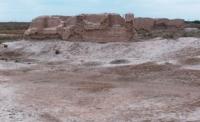Вы здесь
Geoktchik Depe.

Round trip from Ashgabad to Merv ancient settlements.
An Iron Age Architectural Complex, the oldest occupation of the Misrian plain is from the Iron Age, displaying the same cultural material, characterized by a large proportion of grey pottery, as in north-west Iran is represented at the archeological site of Geokchik Depe (ca. 15km south of Dekhistan ruins).
Around the middle of the 2nd millennium populations having a great mastery of irrigation establish themselves and develop an important irrigation network. Thus the main area of human occupation is concentrated in the south of the plain near the Atrek River from which the main canal took its water.
All chronological indices tend to prove that the construction of the massive monument at Geoktchik Tepe began at a relatively ancient date in the period of archaic Dehistan - the end of the 2nd millennium or at the very beginning of the ist.
Continued excavation of Geoktchik Tepe will enable the plan of the complex to be established and to determine its origins, whether they are Iranian, Median or just Central Asian. The interpretation of its buildings remains a riddle.
Their particular architecture and massiveness do not suggest a fortress (no defensive function can justify walls of such thickness) or the residence of some local elite. For the northern building at least, it is convenient to suggest the hypothesis of a sanctuary.
A second part of the excavation program concerns the rectangular enclosure dating from the Sasanian-Islamic period (6th cent.AD), which is 223 m long by 206 m wide. The gate to the east shows an incontrovertible Arab influence and its architecture is directly comparable with that of the Umayyad desert 'castles' (8th cent.) of Jordan, such as that at Kharana.
The Domestic Building - moreover, partial excavation of the most important tepe surrounding the enclosure (1.5 m high) has continued. It consists of a large dwelling (excavated over more than 200 sq. m) in the centre of the area formed by the enclosure where three rooms and two halls have been cleared.
A few remains collected suggest an attribution of this structure to the 7th-8th cent AD. Very little material was found during these operations where the floors had been only partly disturbed by any domestic habitation.
However, the pottery collected is characteristic of the Sasanian-Islamic period of Dehistan as well as that of the Gurgan plain. Most of the ceramics are a bright red, sometimes smooth and frequently comb-decorated with wavy lines.
A beige yellow paste is also seen as well as a rough pottery close to that of earlier periods (archaic Dehistan). Many more evidences of ancient life in Misrian plain can be seen while driving north of Dekhistan, represented by numerous “Depes” or “Tepes” scattered here and there along the route to Balkanabat (formerly Nebitdag), the administrative center of Balkan region of Turkmenistan.
Authority:
On materials of information department of the State committee of Turkmenistan on tourism and sport. "Religious and spiritual monuments to Central Asia". Author M. Hashimov. Saga publishing house, 2001.
Photos:
Alexander Petrov.







